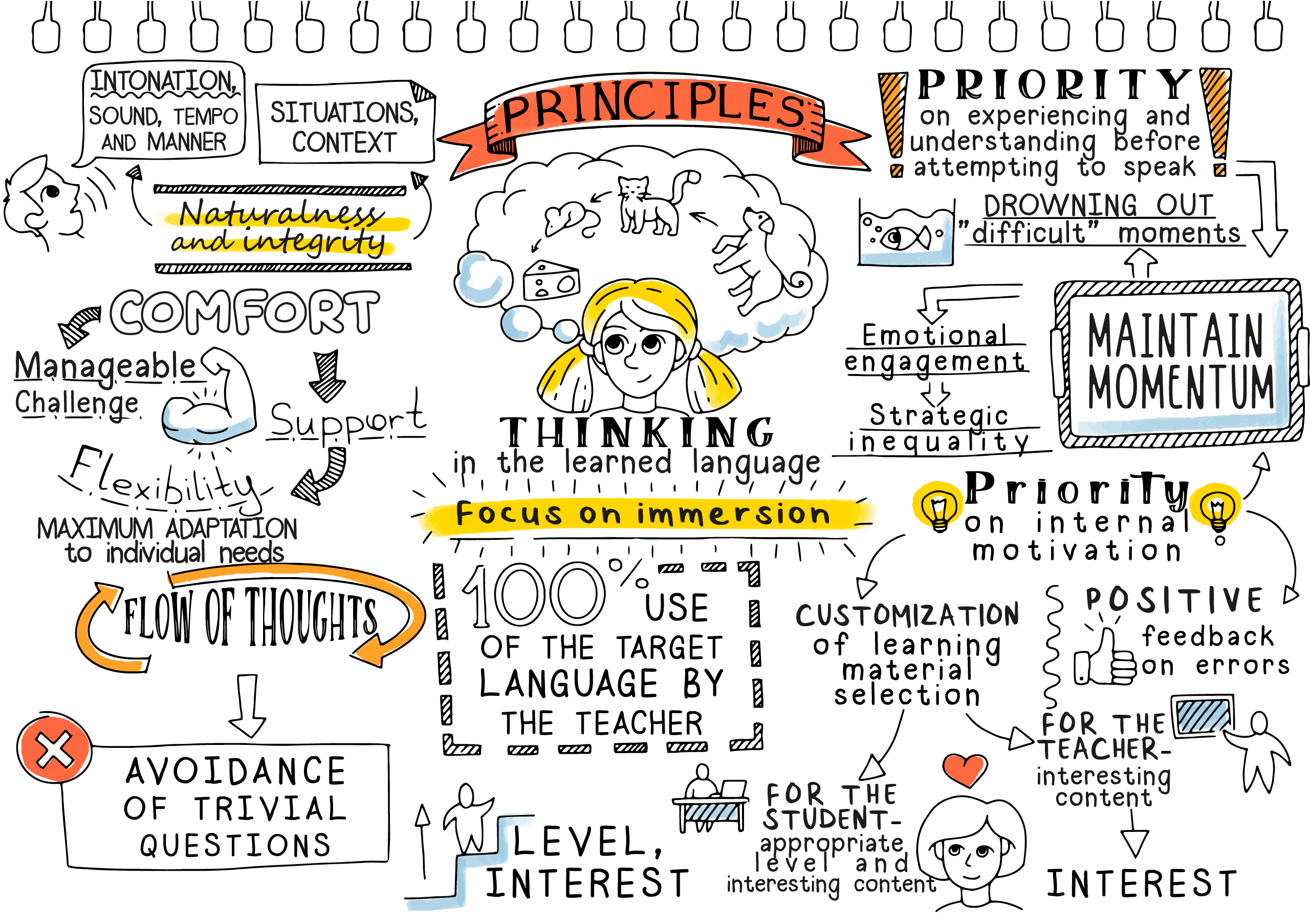| Switch to Russian |  |
OSMTeaching (Organic Structure of Mindful Teaching) is a methodological standard designed to immerse learners in a living language environment from the very first lesson.
The core focus of OSMTeaching is thinking in the target language, experiencing meaning through real-life situations, and developing language as a tool for cognition and interaction, not as an abstract subject of study.
Every element of instruction is delivered exclusively in the target language, starting from the earliest stages. This approach requires teachers to master a specific set of advanced soft skills, which form the foundation of the method.
OSMTeaching is not a collection of techniques.
It is a coherent, organic system.
OSMTeaching deliberately moves beyond traditional language-teaching paradigms.
We do not rely on:
the learner’s native language,
rote memorization,
mechanical drills,
explicit grammar instruction as a starting point.
Instead, we create a natural linguistic environment in which learners:
begin to think in the target language,
experience meaning rather than translate it,
perceive language as a living cognitive medium.
In OSMTeaching, language is not the goal itself.
It is a means of understanding the world, acquiring knowledge, and achieving personal objectives.
In a world shaped by:
AI translation,
instant access to information,
global digital communication,
traditional language-learning models are increasingly inefficient.
Methods that require years of effort without developing true thinking in the language force learners to choose between:
mastering a language, or
pursuing their professional or academic goals.
OSMTeaching eliminates this conflict by focusing on:
soft-skills development,
intercultural competence,
linguistic intelligence,
authentic language use.
OSMTeaching consciously rejects artificial educational content.
Our methodology is built on:
authentic literature,
real language,
natural intonation, rhythm, and discourse patterns.
Learners engage with the same types of texts and linguistic input that native speakers encounter. This enables:
the development of verbal intelligence,
intuitive language processing,
natural comprehension of humor, irony, and cultural references.
Importantly, it is often children’s literature that forms the shared linguistic foundation from which native speakers later create inside jokes, memes, and cultural shorthand.
We place exceptional value on teachers.
OSMTeaching recognizes that learner success depends largely on the teacher’s ability to:
create a living linguistic environment,
guide cognition rather than control output,
respond flexibly to the learning process.
In OSMTeaching, the teacher is not a transmitter of knowledge, but:
a guide,
a mentor,
a facilitator of meaning,
an architect of the learning environment.
By mastering OSMTeaching soft skills, teachers:
increase instructional effectiveness,
reduce professional burnout,
experience deeper satisfaction in their work.
OSMTeaching extends far beyond language acquisition.
Our goal is to:
deeply engage learners,
foster intrinsic motivation,
develop skills that transcend grades, exams, and certificates.
By entering OSMTeaching, educators and learners alike embark on a journey of:
professional growth,
self-awareness,
meaningful human connection through language.
The focus is on lived experience, not translation.
authentic intonation, rhythm, and tempo,
holistic language input rather than fragmented elements,
meaning always emerges within context.
a psychologically safe environment,
support instead of pressure,
maximum adaptability to learners and situations.
Trivial questions and interruptions of thought flow are unacceptable.
The teacher does not use the learners’ native language at any stage.
emotional engagement,
deliberate unevenness in delivery,
the “immersion” technique for difficult moments.
positive error processing,
customized material selection:
adapted to the teacher’s style and interests,
aligned with learners’ levels and needs.
We categorically reject:
speech decomposition,
artificial simplification,
slowed or instructional intonation,
fragmented practice.
Prohibited practices include:
reading by letters or syllables,
vocabulary flashcards,
drilling isolated words or structures,
audio materials consisting of disconnected linguistic units.
“The environment may be artificial.
The language within it must be natural.”
We never teach words in isolation.
New vocabulary:
appears only within meaningful context,
is immediately functional,
is easily retrieved in real-life communication.
This approach eliminates the common issue:
“I know many words, but I cannot speak.”
Pair work and parallel activities are excluded in immersion-based instruction because they:
fragment the linguistic environment,
reinforce incorrect speech patterns,
reduce motivation.
We adhere to the rule:
“Correct language must dominate the communicative space.”
Learner errors are considered invaluable teaching material.
Instead of:
correction through reprimand,
delayed error correction,
we employ:
humor,
reflection,
integration of errors into meaningful discourse.
OSMTeaching does not:
require learners to repeat after the teacher,
use mechanical drills,
induce speech through artificial pauses.
Spoken output emerges naturally through:
high-quality teacher discourse,
“four-handed play” techniques,
“completion to unity,”
guided audio scaffolding.
Any form of forced production disrupts immersion and blocks natural thinking in the target language.
Thanks to proprietary delivery techniques:
acquisition speed is significantly increased,
learners achieve strong results with limited weekly contact,
homework remains short, engaging, and independent,
parental intervention is unnecessary.
It is a mindful educational philosophy
where language becomes alive and learning becomes authentic.
If you’d like, I can next:
adapt this into a short marketing version,
create a teacher-facing manifesto,
or align this description with Junior / Junior Plus / MID course positioning.

"The environment can be artificial, but the language used in it should be natural."